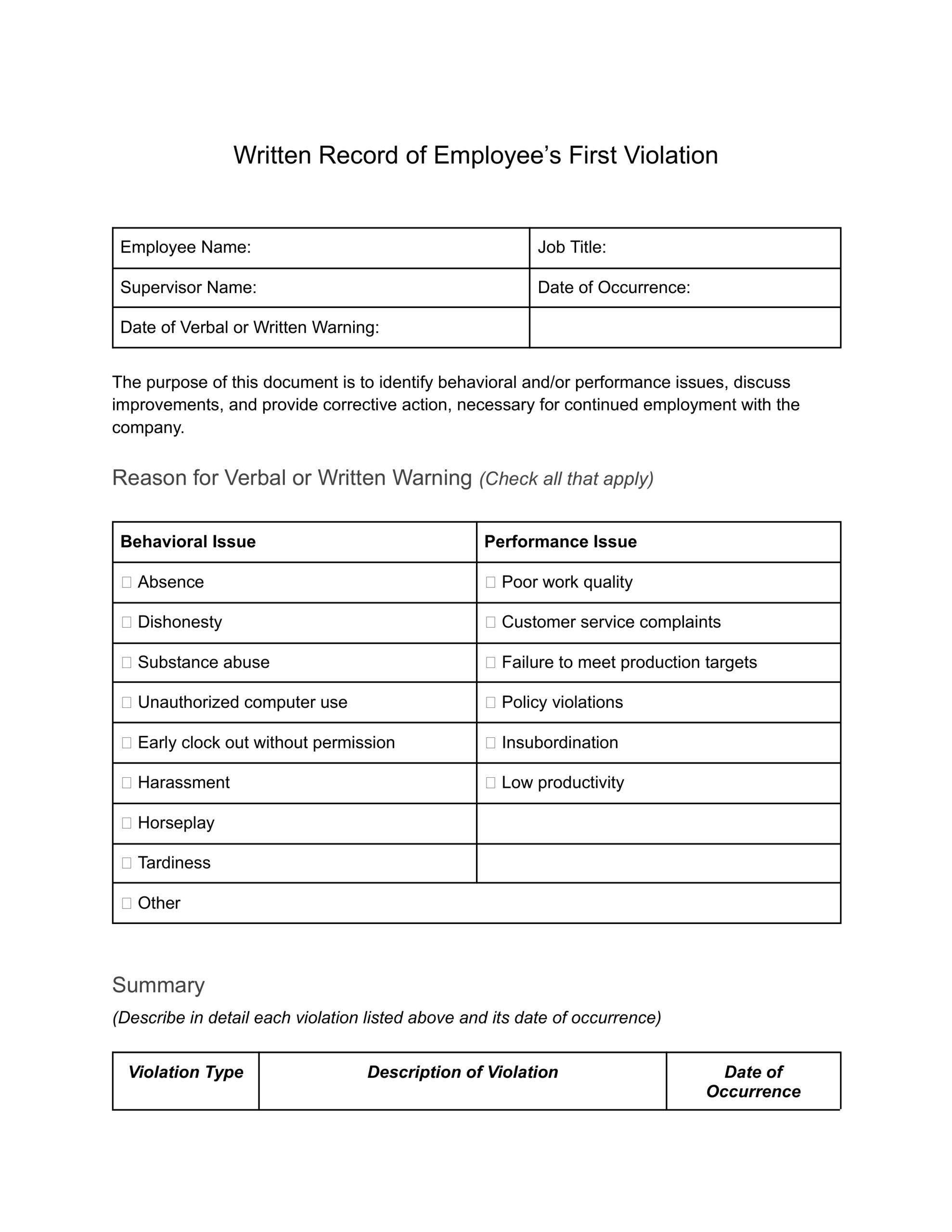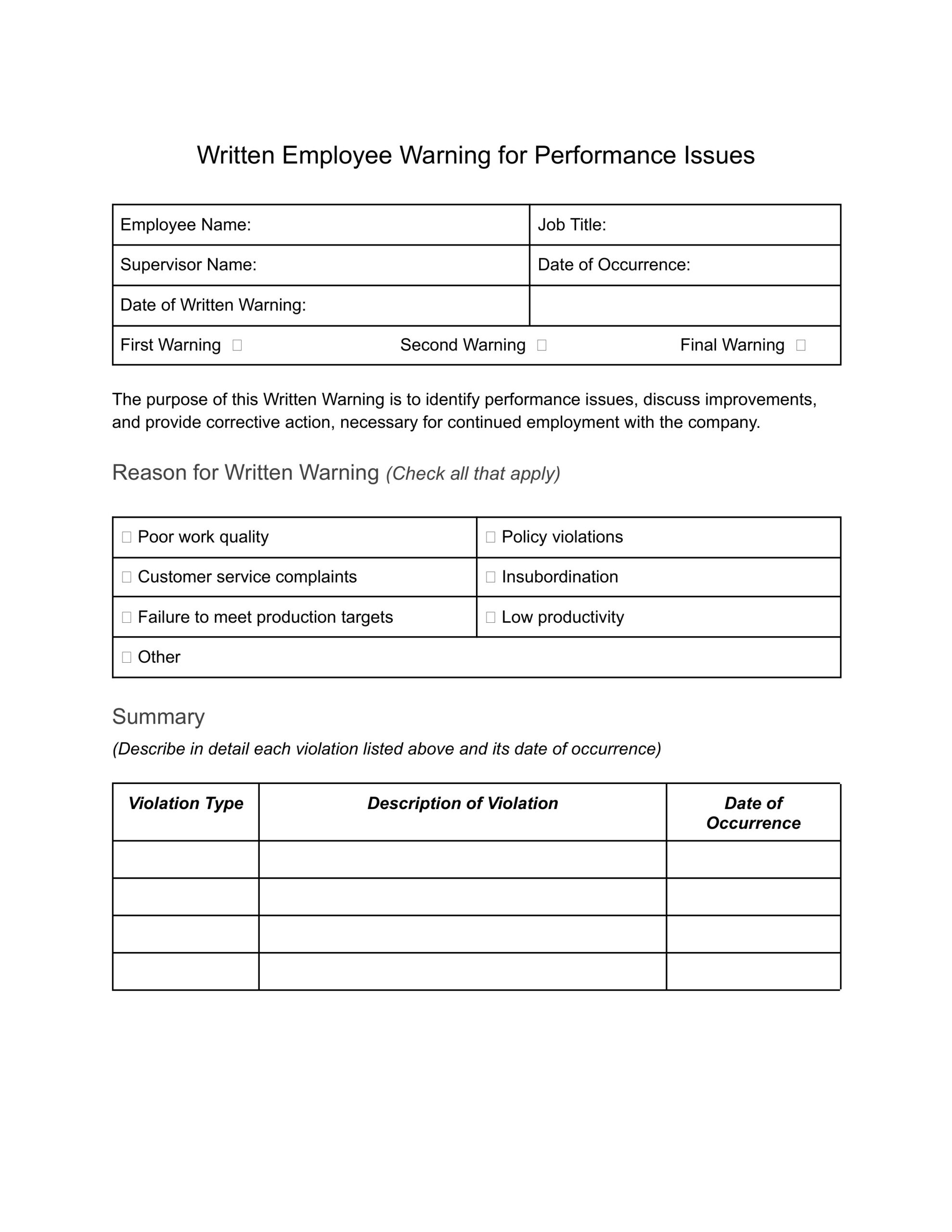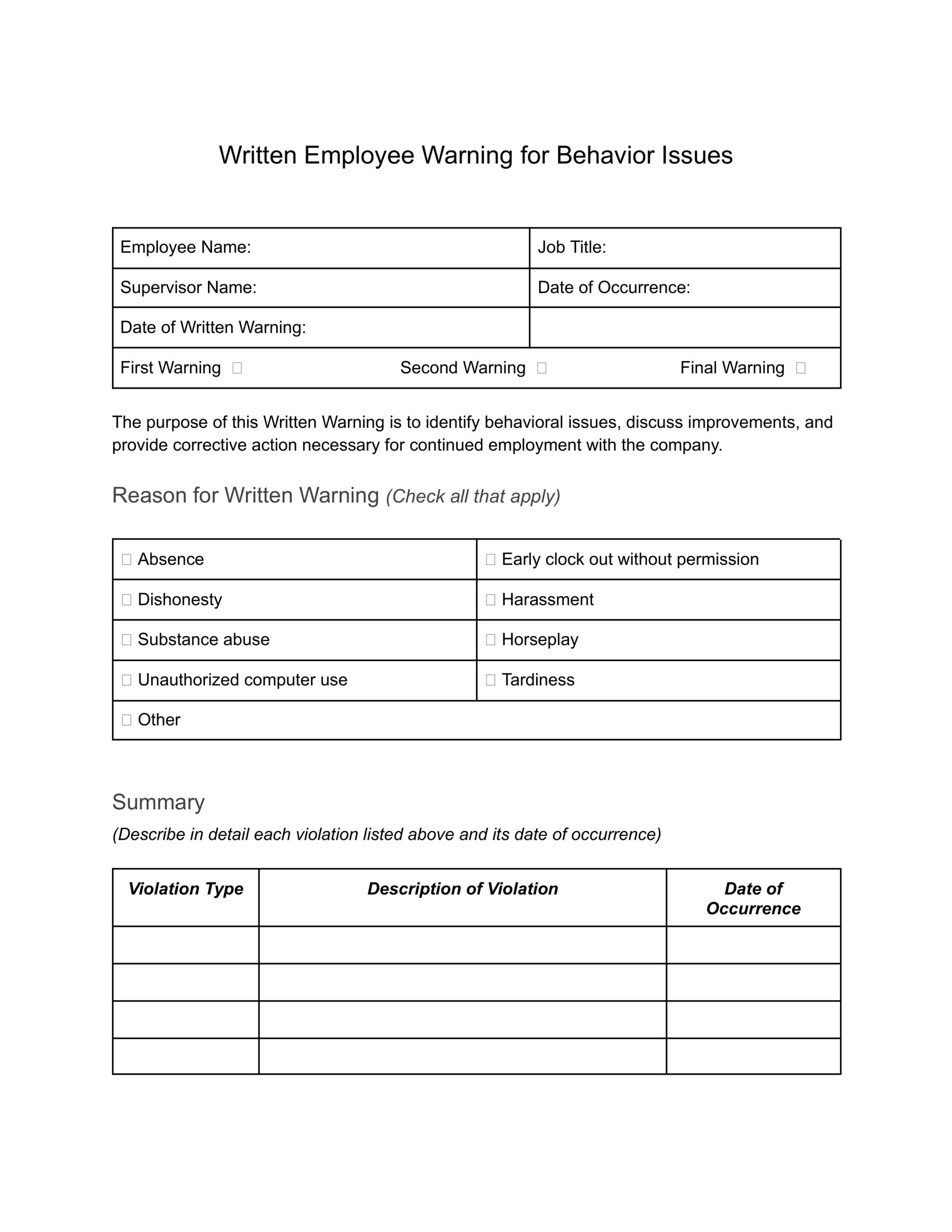An employee write up form is a document that records an employee’s violation of a company policy, behavior issues, or failure to meet stated goals once these reach a point that requires disciplinary action. A write up template should be used company-wide and completed by the employee’s supervisor, HR, or both. Follow your company’s employee discipline policy and process every time you need to write an employee up.
Learn the step-by-step process for creating and managing write-up forms for your employees. Plus, download our free first violation, performance issues, and behavior issues templates to get started.
Key Sections of an Employee Write-up Form
Several key sections help make an employee write-up form more solid, especially in the event of a lawsuit. You’ll need to outline the reason for the write-up in as much detail as possible, along with any dates and related conversations you’ve had regarding the issue.
An employee should first receive a verbal warning as part of a progressive discipline policy. This warning should be documented as a precursor to a formal written warning if the employee does not improve their performance or behavior.

Input the employee’s information, including the date of occurrence and whether it is a first, second, or final warning.
If the employee has already received a verbal warning or a prior written warning, you need to mark the form accordingly—first warning, second warning, or final warning. The purpose of doing so is to communicate to the employee the increased severity of their actions and ensure your company remains compliant by following a fair and equitable process for all employees.
Your employee write-up form should include a reason for the corrective discipline. Regardless of the reason, be honest so your employee can focus on fixing the core problem.
Common reasons for an employee write-up include:
- Violation of company policies, including excessive tardiness or unexcused absences
- Failure to meet company goals and metrics
- Violation of safety policies
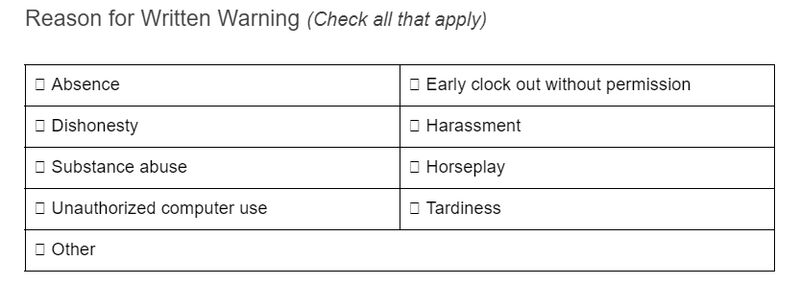
Check the box that corresponds with the reason for the written warning or check “Other” and provide an explanation.
Once you check the reason for the written warning, provide an explanation of each violation that requires corrective action. Be sure to be as detailed as possible so the employee fully understands the reason for the warning.
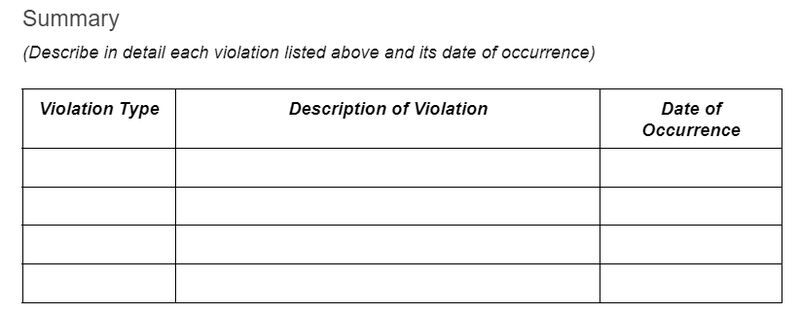
List the violation type, provide a detailed explanation, and the date of occurrence for each violation.
Providing vague reasons or one-word responses will lead to employees being confused. When employees are unsure of why they’re being reprimanded, they can become disengaged and frustrated, having the opposite effect of what you intend. Most employees want to know if they’re not meeting your standards, and they also want to know, specifically, what went wrong and how they can improve. Giving vague reasons makes employees feel you’re setting them up to fail.
Whenever you write an employee up, you need to include notes about prior verbal warnings or write-ups that relate to the present action. Including the history makes it easy for everyone involved to understand why this next step is being taken.
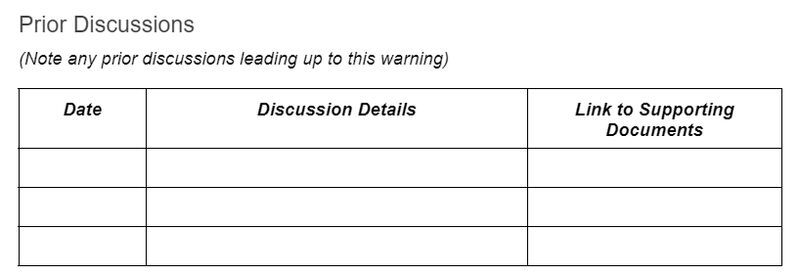
Provide the date, brief discussion details, and a link to support documents.
Ensure that you have documentation of your prior discussions on this topic with this employee. You can keep this section short by referring back to those documents for additional information.
Describing what they need to do to improve their performance or behavior is the most crucial part of the employee write-up form. As the employee’s manager, one part of your role is to ensure your team has the tools to succeed. If you have an employee who is missing deadlines or turning in poor work, it’s your responsibility to redirect them and provide the support they need.
When defining the corrective action necessary, be specific. Include milestones or checkpoints and a timeline to review their performance. Describe how you will be actionably involved and available to help them become successful.
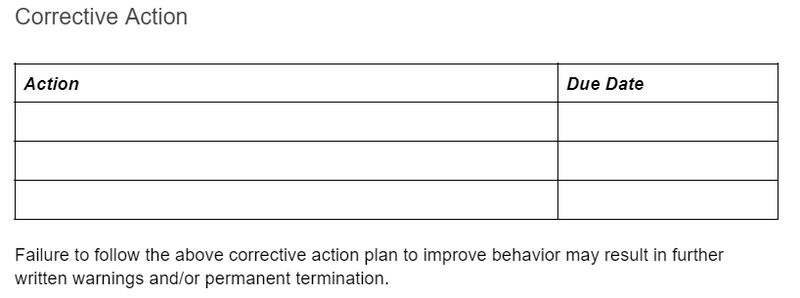
List the action required and due date, and follow up with next steps should the employee fail to complete the actions required.
Discuss what’s next if the employee does not correct their performance or behavior. That could include another write-up or even termination. Be sure to keep this consistent with your company’s progressive discipline policy.
While most employees will sign, some may protest. They may disagree with what is written or simply do not want to acknowledge you provided them with a copy of the write-up. If you encounter this scenario, you can provide space for the employee to write a rebuttal, which can give employees peace of mind that their points are being heard.

Provide space for the employee to list their thoughts.
One of the best ways to ensure that employees sign the write-up is to put acknowledgment language on their signature block stating that the employee only acknowledges they have received the document, not that they agree with everything written. Then have them sign. Signatures are proof that you and the employee spoke about the write-up. Getting the employee to sign a document proves they received and reviewed it.
Some employees refuse to sign a write-up. If this happens, don’t get combative. Instead, document that you gave the employee a copy of the write-up but they refused to sign. Then, have a member of HR sign the document, attesting that the employee received a copy but refused to sign.

Have the employee acknowledge they have received and read the write up document.
The final step on the employee write up warning form is to have a supervisor and/or HR representative sign as a witness.

The employee’s supervisor and a member of HR should both sign the document as witnesses.
Steps to Conducting an Employee Write-up
To successfully complete an employee write-up, follow the steps below.
1. Communicate With the Employee
Never simply hand the employee a write-up form and send them on their way. To show your team that you’re involved in their success, interact with them and discuss how you’re going to help them improve. Whether you’re giving a verbal warning or a write-up, you must discuss it with the employee.
Discussing the problem areas with the employee makes them feel like a valuable member of the team and not simply someone you are looking to terminate. Solid people management skills include the ability to have tough conversations.
For example, if you’re writing an employee up for excessive tardiness, having a discussion with them could uncover the reasons they’ve been late. Don’t just assume ill intent. Understanding the reasons something happens can help you proactively correct the behavior.
2. Follow Through With Check-ins
As part of the corrective action section of your employee write-up form, you will need to include details about check-in meetings and how the employee successfully resolved the issue. Document every check-in you have with the employee, discussing their progress and any support you have provided. Remember, your goal is to help the employee succeed, and that will include involvement and effort on your part.
Sometimes an employee write-up does not end successfully. When that happens, you may decide to end the employment relationship with the underperforming employee.
3. Store Employee Write-up Forms
Always provide a copy of a write-up form to the employee and keep the original in their personnel file. Limit access to employee personnel files to HR only to help ensure that employees’ information is kept confidential and your company respects their privacy.
When there’s an employment dispute or a former employee sues for wrongful termination, the first document request from their legal counsel will be for the employee’s personnel file, which contains their write-up forms. If you don’t have those forms in the employee’s file, you don’t have evidence supporting your decision to terminate an employee. This could be a costly oversight.
Next Steps: What to Do After an Employee Write-up
Aside from making sure you keep records of all written warnings, be sure to follow up with the employee regarding their corrective action plan and areas for continued improvement.
- Continuous feedback: Instead of just providing an employee with a written warning and then leaving it up to them to correct the issues, continue to provide counseling and constructive feedback throughout the process.
- Deadline check-ins: You will give deadlines for corrective actions on the write-up form. Depending on the timeframe, you should check in periodically to assess the employee’s progress. For example, if the deadline for correction is 90 days, check in with the employee at 30 days and 60 days to assess their ongoing progress.
- Morale pulse checks: When an employee is written up for any reason, it can decrease their morale. While it likely will increase their productivity (because they want to show they can do the job), they may feel overwhelmed, despair, and a lack of interest. Be sure to encourage them and check in on their morale from time to time.
- Training: Consider offering training and development to help the employee with their corrective action plan. For example, if the issue was behavioral, you can offer harassment or time and attendance training. If the issue was performance, you can offer customer service or policy training.
- Continued Engagement: A written-up employee can have a lack of trust for the company as a whole. This is an emotional response to being “called out”. Continue to enhance your company culture to increase employee engagement.
Employee Write-up Form Frequently Asked Questions (FAQs)
A detailed write up form example should include the reason for the formal write up for the employee, any prior discussions, and corrective actions. Additionally, have the employee sign the document as an acknowledgment of the write up. It should also be signed by the employee’s manager and/or a member of HR.
An employee disciplinary action form template is usually focused on performance or behavioral issues. These write ups typically come from a manager or supervisor but can also be handled by human resources (HR). HR will also sign the form and keep a copy in the employee’s personnel file.
The format you choose to use for an employee write up is up to you, however, we recommend including the reason why the employee is being written up and a course of action for correcting the behavior.
Bottom Line
Completing an employee write-up form is a necessary part of managing employees and an effective tool for disciplining employees. Through proper documentation, you can help your employees be better workers and give your company firm footing if an employee ever alleges discrimination or wrongful termination.
